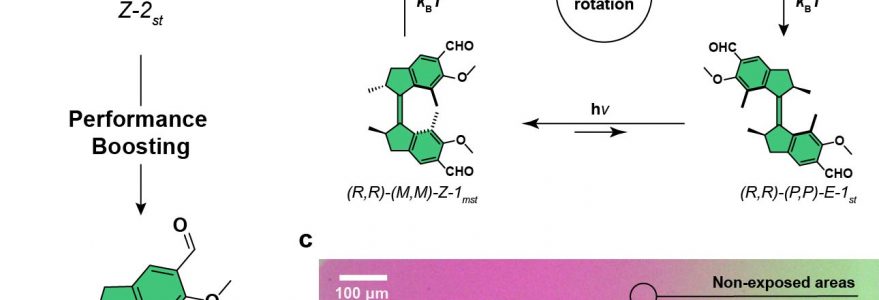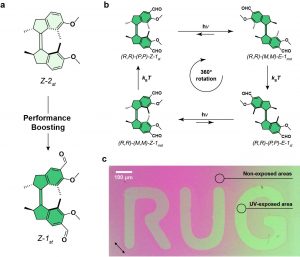Molecular motors based on overcrowded alkenes are synthetic machines that, powered by light, perform controlled, unidirectional rotations of one part of the molecule relative to the other. Dr Wojciech Danowski from the UW’s Faculty of Chemistry is a co-author of a publication describing how to drastically increase the efficiency of these nanoscale motors, approaching the theoretical maximum. The work was published in “Nature Chemistry”.
Biological molecular machines, such as motor proteins kinesin and dynein, are responsible for nearly all aspects of the metabolism of living organisms. Overcrowded alkene-based molecular motors were first developed by Professor Ben L. Feringa of the University of Groningen, a laureate of the Nobel Prize in Chemistry in 2016. A full 360° rotation performed by these molecules proceeds in four controlled, alternating steps: two photochemical isomerizations of the double bond and two thermal isomerizations.
“It is the photochemical step that limits the use of photon energy and thus the efficiency of these motors. The work of these molecules is quantitatively described by the parameter ‘quantum yield’, which is the ratio of photons used for photochemical isomerization of the double bond to all absorbed photons. Even though these machines were developed almost twenty-five years ago, all the efforts dedicated to the increase in the efficiency of light energy usage failed,” explains Dr Wojciech Danowski from the Faculty of Chemistry at the University of Warsaw.
Surpassing the Nature
Dr Danowski, in collaboration with research groups of Prof. Ben L. Feringa, Prof. Wybren J. Buma, and Prof. Wesley R. Browne (Netherlands) and Dr Stefano Crespi (Sweden), developed a simple modification of the core of molecular motors, leading to a dramatic increase in light utilization by molecular motors. The researchers demonstrated that attaching a formyl group to the aromatic core of the motor increases the efficiency of photochemical isomerization to 80%, while minimizing the involvement of side processes. This record quantum efficiency value is particularly impressive compared to the quantum efficiency of rhodopsin isomerization (67%) – a protein that living organisms have evolved for the most sensitive light detection, which simultaneously constitute a benchmark for the efficiency of photochemical double bond isomerization. Besides increasing quantum efficiency, this modification leads to a bathochromic shift of the motor’s absorption bands, making these modified motors attractive chiral and photosensitive additives for liquid crystal phases.
“Our research shows that synthetic molecular machines have virtually unlimited potential, far beyond that of their biological counterparts. Thanks to synthetic chemistry, we are not limited to merely pursuing the Nature, but we can also surpass it. Although the results of this research are incredibly exciting, we still have much work left to do,” Dr Danowski explains.
Publication details
J. Sheng, W. Danowski, A. S. Sardjan, J. Hou, S. Crespi, A. Ryabchun, M. P. Domínguez, W. J. Buma, W. R Browne, B. L. Feringa, Formylation boosts the performance of light-driven overcrowded alkene-derived rotary molecular motors, Nature Chemistry 2024, https://doi.org/10.1038/s41557-024-01521-0




